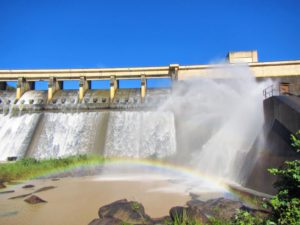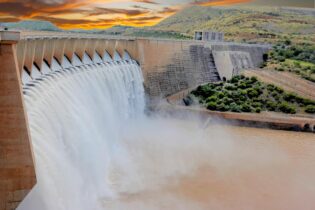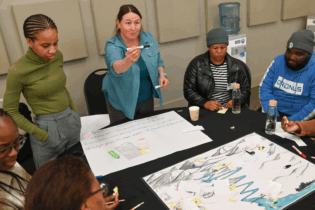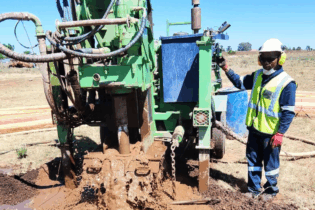South Africa has a history of building dams to address water security needs and to provide essential bulk water supply to its population. Several large dams are steadily losing storage capacity each year due to soil erosion and land clearance, with many smaller farm dams now full to the brim with silt.
Dams disrupt normal surface water and sediment flow, leading to sediment being trapped and unavailable for essential downstream ecosystem functioning. This can lead to erosion and ultimately reduce a dam’s water storage capacity over time. Sedimentation rates in South Africa are extremely high. One of the country’s worst-hit large reservoirs is the Welbedacht Dam on the Caledon River in the Free State – which has lost more than 90% of its storage capacity due to siltation. In 2016, the CSIR estimated that South African national dam storage capacity loss due to siltation was 10%. This reduction threatens water security, which threatens food security, ecosystems, and economic progress in the country.National Siltation Management Strategy
In response to this, the Department of Water and Sanitation (DWS) has appointed the Water Research Commission (WRC) to develop the National Siltation Management Strategy for Large Dams (NatSilt Programme). This will represent a collaborative, transdisciplinary approach to tackle the wide spectrum of dam sedimentation and storage capacity challenges in South Africa. The NatSilt Programme is initiated and funded by the DWS through its Infrastructure Build, Operate and Maintenance (IBOM) branch, which is responsible for the asset management and infrastructure maintenance of 276 government water schemes across the country, including 320 large state dams that make up more than 90% of the country’s total storage capacity. Occurring in three phases over three years, the NatSilt Programme is expected to be concluded in 2023. The WRC will be developing a package of siltation management solutions that include relevant tools, models, frameworks, protocols, guides and plans in order to assist with the implementation and monitoring of the strategy. This will help the DWS in ensuring sustained supply to domestic, industrial and agricultural bulk water users, as well as save scarce financial resources by extending the life cycle of existing dams. Among the vital insights that have been gleaned so far include the role municipalities play in the maintenance of the catchment areas and how crucial it is that there is cooperation between the various government departments in ensuring the programme’s success. “We have established our whole economy and livelihood around these majestic dam structures, but we can so easily lose them if we don’t apply proper management procedures to keep them in that state,” says Leonardo Manus, acting deputy director-general: Regulations, Compliance, and Enforcement at the DWS. Manus adds that the NatSilt Programme will provide the department with the tools and intelligence to make appropriate, site-specific decisions regarding each dam, instead of using a blanket approach. “Where sedimentation occurs to such an extent that it has to be dealt with, we will create a business model that will not be to the detriment of those who are dependent on the dam. To minimise costs to the downstream users in that specific catchment, we need to find alternatives to expensive methodologies and dredging models deployed to keep any dam operating.”A coordinated approach
For dam siltation management to be successful, the efforts need to address the state of the existing dams, how they should be operated and the activities within their respective catchments. While addressing dam engineering components of dam siltation management, it is equally important to address the socio-ecological systems aspects of it. Among the components of dam siltation highlighted by the programme implemented by the WRC is the development of a dam classification framework and dam operations model. The classification framework aims to classify dams from exhausted to sustainable and subsequently inform the development of the operations model. The dam operations model will recommend strategies suitable for operating specific dams. Dam engineering has an important role to play in safeguarding water security. However, the design and construction of these dams need to consider their impacts on society and ecological systems. The way in which this has been done in South Africa has resulted in dam siltation not being managed adequately. This can be attributed to the inconsistent monitoring efforts and lack of holistic approaches when dams are being designed and constructed. This negatively affects the lifespan ofthe dams. At a global level, concern is growing about declining dam storage levels due to siltation, increased human populations, urbanisation, as well as exacerbated storm erosion linked to climate change. “By 2050, roughly 64% of the world’s current reservoir storage capacity could be filled with sediment.” says Professor Gerrit Basson, who is head: Hydraulic Engineering at Stellenbosch University’s Civil Engineering Department, former chairperson of the reservoir sedimentation committee of the International Commission on Large Dams (ICOLD), and a current member of the World Bank-Unesco Task Group on reservoir sedimentation management. ICOLD assessments suggest that several countries – almost a third of them in Africa – could therefore experience critical sedimentation volumes by 2050.
Management strategies
Several management strategies to combat and prevent siltation have been explored and implemented – including extensive catchment management strategies focusing on land-use practices and restoration, in an attempt to minimise soil erosion – effectively treating the problem at the source that often contributes the majority of sediments.Other management options include the construction of upstream ‘check-dams’ to aid in trapping sediments during flood events, by-passing schemes via tunnels or off-stream dams, as well as flushing or sluicing techniques. These strategies provide alternatives to the traditional approaches of simply raising dam walls or constructing completely new reservoirs, which are both often extremely expensive.
Locally, less emphasis should be placed on strategies in reservoirs that rely heavily on water, such as flushing and sluicing, and more on alternative measures. This is because South Africa is largely an arid environment, so most dams do not have the excess water available to carry out these operations. There are also potential problems downstream because of the release of large volumes of muddy water that can inundate river beds and have drastic effects on downstream ecosystems if they are not properly planned.







